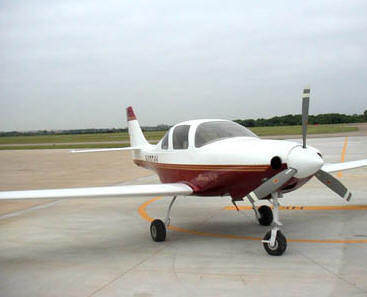

That
First Flight...It Had Better Be Right
by
Lorin L. Wilkinson
|
You've heard that song before, I'm sure. Well, perhaps there is good reason it gets played so often. The majority of homebuilt accidents and incidents occur during the initial test flight or during the first few hours of flight time. This is also evident during the familiarization period with a newly purchased G/A aircraft, especially one with greater performance and more bells and whistles than the aircraft we had been flying. We all love to climb the ladder, don't we? Here is a little, but revealing, test that I wish each of you would take before you "kick the tires and light the fires" on that next first flight. Look into a mirror! The 15-coat, hand-rubbed finish on the vertical stabilizer or the polished canopy of your "new bird" will do in a pinch, but you really want to be able to see into your own eyes. When you establish that eye contact, ask yourself with all sincerity, "What are my buns worth?" Don't snicker! Don't shrug and say, "I can handle it." Can you, really? You are about to risk your buns here; you had better be sure! Do you have the qualifications and experience, recent experience, to do the job? Are you knowledgeable and prepared to deal with any discrepancy, irregularity, or emergency that might occur? Will your actions and reactions be timely and correct? Hey, I sure hope so; it's your buns not mine! Here are a few thoughts you might want to consider. |
 |
Your aircraft: You have spent many months, even years, building your dream bird. You have done absolutely, without compromise, the best work you could possibly do, using the finest materials available. You have never ever uttered or even thought the phrases, "That's good enough" or "It's done now and I'm not doing it over." You have had numerous inspections by your EAA Chapter Technical Counselors and have heeded their advice and suggestions. To paraphrase that master builder, Tony Bingelis, "There are about 100,000 steps in building a homebuilt. If you are 99.9% perfect you still have screwed up on 100 and you had better be sure that they are only cosmetic!"
A suggestion: A few days before the big event, invite several Technical Counselors to give your aircraft a thorough preflight inspection and to note all discrepancies. You might be surprised, and possibly relieved, at what they might find. [Editor's note: Don't forget that the FAA has to issue an Amateur-built Airworthiness Certificate before that first flight can even be considered.]
Yourself: Many builders let their flying skills stagnate during the building process as all extra cash and time are committed to the project. You must now take the time to get current and qualified. Study and pass that BFR you have been putting off, and make sure you have a current medical as well. Spend a few air hours sharpening up on the maneuvers that you'll be performing during your test period: slow flight, stalls, spot landings, including simulated engine failure or other emergency induced landings. If possible, get some time in an aircraft like the one you will be testing, at least one with like flight characteristics. Contact other owners of aircraft like yours and discuss flight characteristics, performance data, and any idiosyncrasies they may have discovered during their flight testing. Flight reports in magazines tend to be flattering and favorable. Few aviation writers tell the real story, overlooking the bad stuff, as they want to be invited to do another flight report in the future. If your aircraft is a taildragger, currency in a taildragger is a must. In short, prepare yourself as thoroughly as possible for the job ahead.
Location: Very few of us are fortunate enough to be living on an airfield that is suitable for flight testing our homebuilt. Some of you will have but one choice. The ideal site for me would be a sod runway of adequate length, without obstructions, no tower, and far enough from town to afford plenty of off airfield landing sites. With this set-up you will have no crowd of gawkers, you will probably be the only one in the traffic pattern, and you will not have the additional work load and distraction of talking to a tower. The sod runway is especially beneficial if you are testing a taildragger. Fire equipment? Bring your own. A number of good sized CO2 or Halon extinguishers in the back of a pickup will do. To be blunt, impact trauma causes the majority of injuries and/or death in light aircraft accidents, not fire. A well-equipped EMT would not be a bad idea as well as some cutting tools such as a hack saw and bolt cutters and perhaps a cellular telephone to summon help if needed.
Ground Crew: A test flight is not the time for a family reunion. Children are particularly disruptive and distracting. You need no more than three knowledgeable, reliable helpers. At least one should be your local EAA Flight Advisor with a handheld radio, someone who can answer your questions if you have them or supply information when needed. All should be familiar with and be briefed regarding your aircraft and your requirements as well as your flight plan. They should know the location of, and how to operate, the safety and emergency equipment.
The Big Day: Do not set an irrevocably given day for your first flight. Choose a period of ideal flight conditions then go when the conditions are right. You don't really want to be fighting a gusty crosswind on a first flight; there is always a better day coming. Be sure to re-brief your crew on your game plan and emergency equipment if you have to reschedule. We will assume that you have completed your taxi tests, both slow and fast, and that you have corrected any discrepancies. Do a thorough preflight...again. Limit your first flight to exploring only a few parameters. Control response and effectiveness, slow flight, and approaches to a stall would be more than adequate. This will give you a feel for the aircraft during flight, approach, and landing. You should also note your engine performance and radio the readings to your handy Flight Advisor who will note them for the record.
There is absolutely no substitute for thorough planning and preparation for a first flight. That includes keeping disturbing distractions to an absolute minimum. You will have enough on your mind and enough to do without having to crack the whip in the center ring. There will be time enough to show off your pride and joy after you get in a few flights and a few hours. You will also be more at ease and enjoy it more then as well.
Building, then flying, your homebuilt for the first time will be one of the most rewarding and satisfying experiences of your lifetime. Make sure that you will be able to share this adventure with your great grandchildren.
Light winds and smooth air!
The author began flying more than 50 years ago at the age 15. He has flown nearly 30,000 hours in numerous types of aircraft and vehicles from the Hiperlight ultralight to the Douglas DC-10, including 2,500 hours instructing primary through instrument and multiengine. He is now building his third homebuilt, a Hatz XB-2 biplane. This article originally appeared in the EAA Flight Advisor Newsletter.
To view an informative new FAA video called "First Flights in Your Ultralight or Light Plane," contact the Safety Program Manager at your local FAA FSDO.
| ?AvStop Online Magazine Contact Us Return Home |